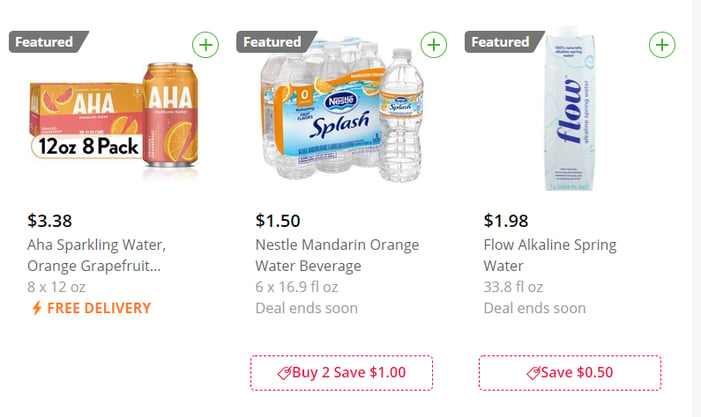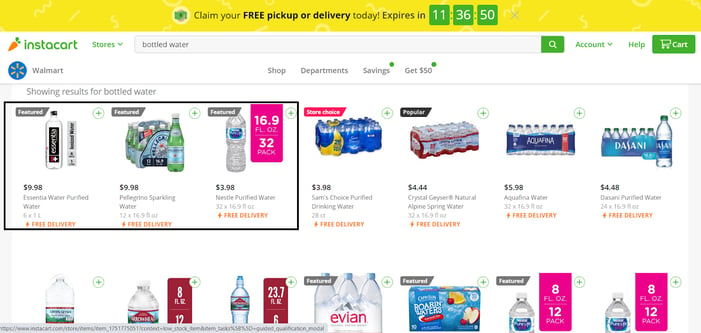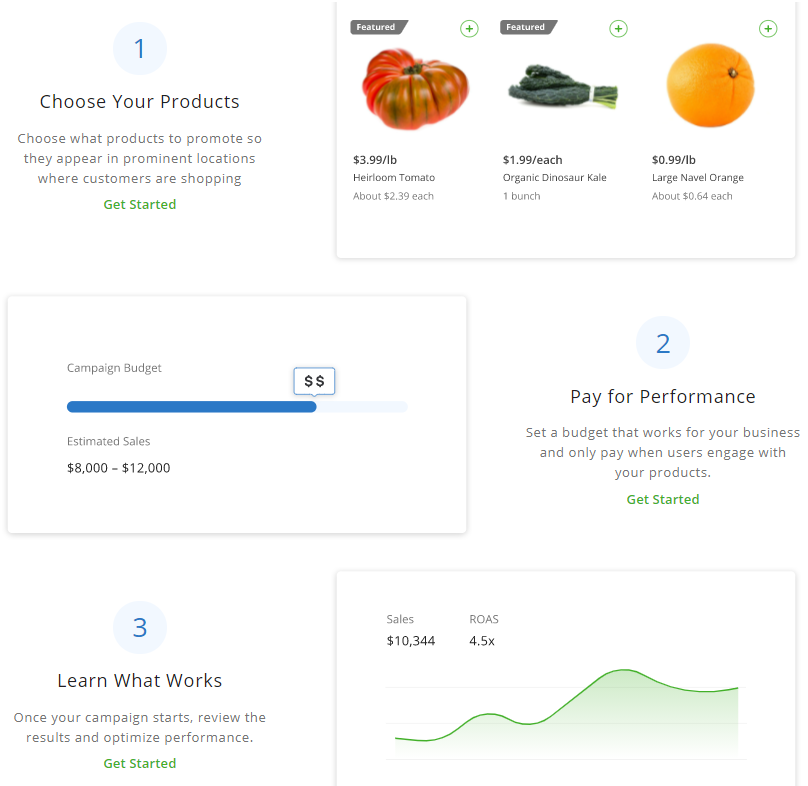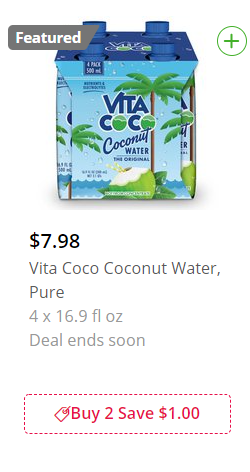
Need to understand Instacart advertising?
Bobsled Advertising Director Stefan Jordev has provided his insight below.
Why should brands be considering Instacart advertising?
- Instacart is here to stay. The pandemic primed consumers and the market for Instacart, but the platform has undeniable staying power beyond COVID-19. According to Catalyst and Kantar’s original ecommerce research, 63% of online purchasers who have used Instacart, plan to use Instacart more in the future. Instacart represents one of the largest areas of ecommerce growth.
- Instacart has unrivaled scale & data. Instacart leads online grocery in North America, spanning 25,000 brick and mortar stores across more than 5,500 cities in the US and Canada. This scale enables brands to gain insights into typically hard-to-get inventory data across locations and regions, empowering strategic decisions for marketing, supply chain management, and more.
- Instacart is more than traditional grocery. Instacart isn’t just food. It encompasses the whole grocery store, so brands traditionally in the center aisles in store or brands whose products have not been well suited for ecommerce historically (like perishables) can now advance their ecommerce position and create new revenue streams. Instacart also unlocks opportunities for advertisers in the alcohol and spirits category who are unable to market online with traditional retailers.
What type of advertising can you run on Instacart?
Instacart offers a self serve campaign type called Featured Product ads. This ad type resembles Sponsored Products placements on Walmart or Amazon.
The main similarities are the Auto and Manual targeting options. With Auto targeting, Instacart displays your ads next to the most relevant products according to their own algorithm, and with Manual targeting you set up bids based on keywords that you select yourself.

Above: Examples of 3 Featured Product ads on Instacart - the grey ‘Featured’ tag indicates that the placement is an ad.
Instacart uses a second price auction model similar to Amazon for Featured Product ads. This means that advertisers will pay $0.01 more than the next highest bidder for a keyword. Winning bids are based on a combination of the CPC bid and search term relevance. Exact match targeting only. No negative match keyword capability or ability to block campaigns from bidding on anything specific.
Who can I target with these ads?
Featured Product ads target potential buyers on Instacart who are searching for terms that match the products you are promoting.
See the below example for a ‘bottled water’ keyword search on Instacart. The results are as follows:

The first three results are featured offers. This means that Essentia, Pellegrino and Nestle are using Instacart’s paid advertising solution to rank ahead of the competition.
Importantly, in terms of reaching potential customers through Instacart advertising, there are geographical limitations to consider.
“Customers can only order products on Instacart from stores in their area,” explains Stefan. “If no local stores have your product in stock, your ad won’t run, and your product won’t appear anywhere in the organic search results either.”
How do you set up Instacart ad campaigns?
Instacart advertisers select which products to promote, set a budget, and tweak campaigns to improve performance.

Above: Screenshot from Instacart
Strategy
- A good place to start advertising on Instacart is by replicating your top-performing campaigns from Amazon.
- Use your top-performing search queries, not keywords, since Instacart uses exact match targeting.
- Filter your Amazon campaigns by high ROAS and impression volume, and export the highest search queries to use in your Instacart targeting.
- Creating product segments by price tiers will drive better results since it enables optimizations to account for ASP. In other words, you are able to bid more aggressively on higher ASP items, because they are able to absorb the higher bids.
Campaign Structure
- No SKU limit, but a keyword limit of 1,000 keywords per ad group
- Multiple ad groups per campaign. Best to create tiered campaign structures (like Amazon)
How do you measure success with Instacart advertising?
Successful campaigns on Instacart are no different to other platforms when it comes to measuring KPIs. In order to be successful, your Instacart campaigns must align with your budget, sales targets and ad ROI goals.
However, Instacart does offer a unique real-time keyword rating guide, allowing brands to do comparative analysis by estimating a percentage of winning placements with your current bid level.
There are 3 gradings within this system:
- Green: a high probability of winning 50% of placements
- Yellow: a high probability of winning 25% of placements
- Red: no chance of winning any placements
Advertisers can use this guide to optimize spend levels across campaigns.
Instacart categorizes advertisers into 4 different tiers. The more brands spend on advertising, the more audience data and insights they are able to receive from Instacart. Therefore, brands with bigger budgets will have an advantage over competitors about how to structure their ad campaigns.
What are the benefits of Instacart advertising?
Like every new marketplace feature, there’s significant advantages to being an early adopter of Instacart’s advertising solution.

The main benefit at this point of time is capitalizing on the low CPC rates. This means brands can boost total sales whilst sacrificing minimal profit margin. When more brands start advertising on the channel, this will drive up CPC rates. Getting in early to identify exactly how the ad platform can serve your channel goals could save you money over the long-term.
This opportunity is particularly exciting for emerging brands. By utilizing Instacart advertising, brands can position themselves next to the best performers in their category, which are typically large, household name brands.
💡 Check out An Introduction to Instacart For Brands
What are the current limitations of Instacart advertising?
There is the geographical targeting limitation which was mentioned earlier. Amazon advertisers can target any Prime customer across the entire country. Instacart advertisers can only reach customers who live close to stores that carry their items.
Right now, Instacart advertising is fairly limited in terms of functionalities. There is only one campaign type available, bare bones reporting and the only real source of optimization is through bid management. There is an upside though. Brands that develop an understanding of the platform now are going to be much better placed to capitalize as the solution’s scope expands.
If we were to project Instacart advertising’s future by looking at how Amazon has grown, it would be safe to expect additional campaign types, creative input options for advertisers, advanced bidding by placement functionalities, and many more customization tools. It will be very exciting to observe Instacart’s development as a channel!

Apart from advertising, are there other things I can do to facilitate growth on Instacart?
Instacart acquires inventory by tapping into a huge network of brick-and-mortar retailers. So brands can’t directly manipulate pricing and inventory levels on the channel. This creates significant challenges from a marketing perspective.
In terms of non-advertising growth solutions, Instacart does allow brands to utilize some basic promotions such as shipping discounts, BOGO offers. See the below ‘Buy 2 Save $1.00’ offer for Vita Coco Coconut Water.
On the right: Example of a ‘Buy 2’ promo on Instacart
Tagged: Seller & Vendor Central, Amazon Account Management, Grocery & Gourmet Food
.png)

